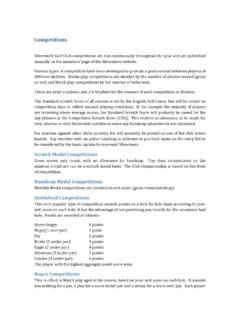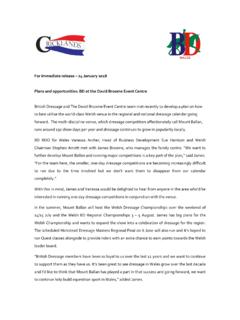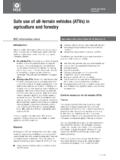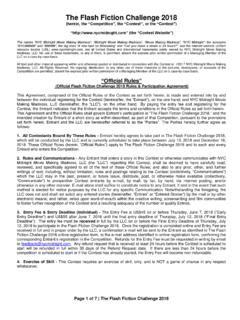Transcription of How Judges Critique Photo Competitions - …
1 CLICK HERE TO RETURN TO ICONICPHOTO FEATURED ARTICLES PAGE HOW Judges Critique Photo Competitions : ARTISTIC CRITERIA AND TECHNICAL STANDARDS Shutter Release, December 2011 Deeply appreciated is the Photo competition judge with the knowledge, empathy and wit to provide constructive praise and criticism of each and every entry. This may not always occur because of personal style or time constraints, but all Judges add to our learning, and we can only be grateful for their efforts on our behalf. As an assist to the perplexed photographer whose masterpiece may have been turned aside in competition by an Out, Next, or We ll keep this in for now, this article discusses the artistic objective and considerations weighing in Photo Competitions , and summarizes technical reasons why submitted images don t make the grade.
2 The Main Criterion: Photography as Art To place in Photo Competitions generally, an image has to be seen as art. When is photography art? The most uniformly accepted criterion over the past century and a half defines art in photography as an image that evokes emotion, be it beauty, admiration, pathos, humor, intrigue, pity any one of innumerable human feelings. To be considered art, a photograph has to be virtually free of technical flaws that would distract from the essence of the image. Since the absence of basic shortcomings is normally a prerequisite for qualification of a photograph as art, most Judges begin a Critique of an entry by noting any significant technical flaws.
3 Technical Critique of Photographs In normal vision, our mental image is of a naturally composed scene in focus, with appropriate contrast and perspective, and unimportant effects diminished ( , glare on a polished floor is nearly as bright as the lights above it, but when we view the scene, the effect appears quashed and the impact of the glare muted). On the other hand, when a photographer captures the same scene in a two-dimensional image, it becomes a step removed from our unconscious mental processing, and the reflection of the glare appears - 2 -very distracting.
4 If the glare is not toned down, it will become an object of attention and distract from the artistic potential of the image. Similarly, it is incumbent on the photographer to provide correct focus, proper exposure, adequate contrast and sensible composition, since the mind s eye does not adjust for such factors once an image is set to monitor, projection screen or print. Most technical flaws cited by competition Judges can be summarized as follows: 1. Out of focus: A main subject or a part of it may be blurry (or soft ). Another potential distraction occurs when background intended to be out of focus, as in a vague blur, instead appears partly in focus (a tweener ) which can distract from the main subject.
5 2. Vacant space: A sizable part of the photograph is empty or has no meaningful content, to an extent that the view appears wanting. 3. Objects out of synch or cut off: Even slight distractions such as an odd hand, bright color or shadow appearing in front of or behind a main subject may cause an image to be rejected. Viewer focus may also be interrupted when a significant element or parts of the image are cut off by the borders of the photograph. 4. Excessive contrast: One or more areas or colors appear too bright or dark. Unless an image is obviously abstract or includes an intended area of dark shadow, all significant areas of a Photo should be lit adequately to show some texture or other detail.
6 5. Hot spots: When lighting is not uniform, a photograph may have a few areas of particularly bright illumination that detract from the image. 6. Weak coloration: Faded color, or a gaping absence of tone where strong color saturation would normally be expected, is considered a technical fault by many Judges (for example, a substantial white (or bald ) sky.) 7. Over-saturation: Colors appear too strong or exaggerated for effect. 8. Overuse of HDR: In the past few years, some Judges have expressed dislike for what appears to them as excessive application of HDR (high dynamic range) as indicated by unnatural skies or other odd-looking hues.
7 9. Over- or underexposure. A relatively rare occurrence these days with automatic exposure control with digital imaging. 10. Glare and the like: Offputting reflections, blurs of motion and other unintended consequences of capturing an image under challenging conditions may also dilute artistic effect. 11. Image not level: Applies particularly to water views and landscapes with horizon, and to architectural photography. Images taken with wide-angle lenses are particularly susceptible. Notwithstanding opportunities for digital correction, a tripod and/or spirit level continue to be recommended for use with wide-angle lenses.
8 - 3 - 12. Presentational faults: Judges may reject print entries because the size is considered too small to effectively illustrate the content. At the other extreme, an organization may have size limitations on entries. Occasionally a judge will rule an image out because a mat is slightly crooked or ajar, or for other such presentational snafus. Serious photographers, of course, are not unaware of these issues. Some flaws can be avoided with adequate preparation, or digitally corrected; yet many shooting situations are so impromptu or otherwise difficult to perfect that technical issues remain a challenge for the most expert photographers.
9 Aesthetic Considerations: Photography as Art Clear of the technical obstacle course, a photograph may illustrate beauty or other impression, powerful or subtle, but still not win an award. The bar is high and may seem unreasonably difficult because of the subjective nature of art together with the straight odds against placing in a competition . Typically between 10% and 25% of entries can win or place, depending on the rules adopted by the sponsoring organization. Of numerous descriptions of the singular impression a superior image may offer, one that succinctly sums it up was remarked by photographer (and competition judge) Lucian Perkins in a talk to the International Photographic Society in Washington DC in January 2001.
10 He advised that a winning photograph, ..must have something that drives me further than the norm. Subtlety with complexity, and that you are compelled to study more, which grabs you. In my experience, a great photograph and sure winner evokes awe, a sense of wonder and admiration that returns with anticipation when the picture is viewed again. Further, especially in situations of tight competition , merit with respect to production of the image may enter into consideration with aesthetics. That is, more than one judge has commented that they assess photographs at least partly according to the care and expertise that appear to have gone into creating the image.






